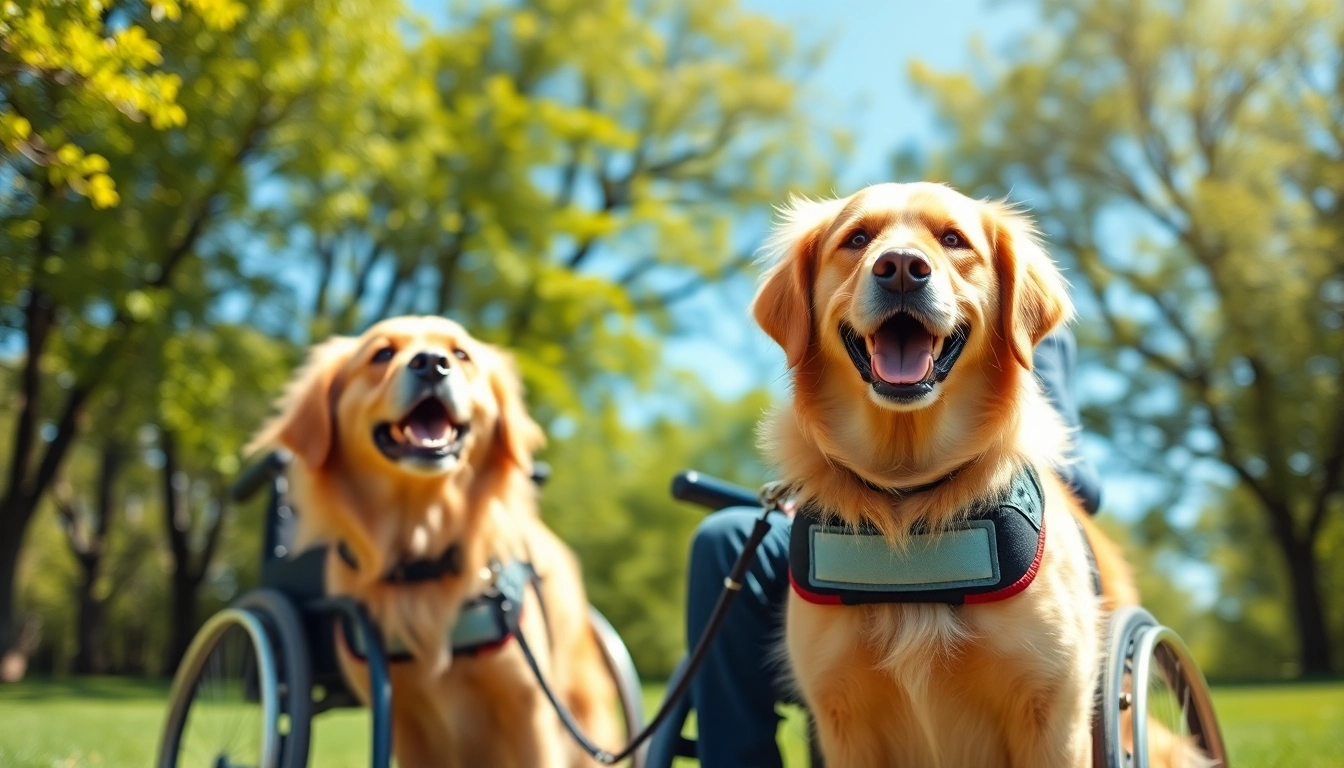Understanding Service Dogs
Service dogs play a pivotal role in the lives of individuals with disabilities, providing vital assistance that enhances independence and quality of life. These specially trained canines are much more than pets; they undergo rigorous training programs to perform specific tasks that mitigate their handlers’ disabilities. If you are considering the possibility to get a service dog, it’s essential to have a solid understanding of what they are and the rights associated with them.
Definition and Types of Service Dogs
A service dog is defined as a dog that is trained to perform specific tasks for individuals with disabilities. The tasks performed must be directly related to the person’s disability. The Americans with Disabilities Act (ADA) identifies three primary categories of service animals:
- Guide Dogs: Assist individuals who are blind or visually impaired.
- Hearing Dogs: Assist individuals who are deaf or hard of hearing by alerting them to sounds.
- Mobility Assistance Dogs: Aid individuals with mobility challenges by providing support for walking or retrieving items.
Beyond these types, other service dogs may be trained to assist individuals with conditions such as PTSD, diabetes, and seizures. Each dog’s capabilities depend on the specific needs of their handler.
Common Disabilities That Qualify for a Service Dog
Understanding the disabilities that can qualify an individual for a service dog is critical. Some of the most common conditions include:
- Physical Disabilities: Conditions like spinal cord injuries or arthritis can benefit greatly from the support of a service dog.
- Mental Health Conditions: Disorders such as PTSD, anxiety, and severe depression can also warrant having a service dog trained to provide emotional support and practical assistance.
- Diabetes: Dogs can be trained to detect fluctuations in blood sugar levels and alert their handlers before a medical emergency occurs.
- Seizure Disorders: Some dogs are trained to respond to seizures, sometimes helping to prevent injury or alerting others for help.
If you believe that you might benefit from having a service dog, a conversation with your healthcare provider can provide clarity on the potential advantages.
The Role of Service Dogs in Daily Life
The role of service dogs extends far beyond assistance in mobility. They can help with daily tasks such as:
- Retrieving items from a distance, such as a phone or medication.
- Providing balance and support while walking.
- Offering reassurance in stressful situations, particularly for those with mental health disorders.
- Alerting the handler to medical emergencies, such as low blood sugar or upcoming seizures.
This multifaceted support can empower individuals, promoting independence while simultaneously improving mental and emotional well-being.
Steps to Get a Service Dog
Acquiring a service dog involves several essential steps to ensure the right match between a dog and their handler. It’s important to approach this process with thorough research and readiness.
Assessing Your Need for a Service Dog
The first step in obtaining a service dog is a personal assessment of your needs. Consider the following questions:
- What specific tasks would a service dog need to perform to assist me?
- Am I capable of caring for a dog, both physically and financially?
- Do I have a documented disability as per my healthcare provider’s assessment?
A clear understanding of your needs will enhance the selection process and ensure that you find a dog suited to assist you effectively.
Finding a Reputable Service Dog Organization
Once you have assessed your needs, the next step is to find a reputable service dog organization. Look for organizations that:
- Are accredited by recognized bodies, such as Assistance Dogs International (ADI).
- Provide training that aligns with your specific requirements.
- Have a transparent application and training process you can review.
Online resources and local community boards can provide valuable recommendations. It’s advisable to attend information sessions or visit training facilities to gain insights into the organization’s practices.
Application and Approval Process
Each service dog organization will have its application process. Generally, it will include the following steps:
- Completion of an application form detailing your disability and the tasks you need assistance with.
- Submission of documentation from your healthcare provider affirming your condition and need for a service dog.
- Participation in an interview or consultation to discuss your needs and expectations.
Acceptance criteria may vary, so it’s important to be aware of the requirements specific to each organization.
Cost Implications of Getting a Service Dog
The financial aspect of acquiring a service dog can be substantial, but there are various options and resources available to help alleviate this burden.
Funding Options and Grants for Service Dogs
Many nonprofit organizations and foundations offer grants specifically for individuals seeking to obtain a service dog. Some key funding sources include:
- Veterans Affairs programs for eligible veterans.
- Local charities and community organizations focusing on disability support.
- Crowdfunding platforms where stories can be shared to raise funds.
Researching these options may uncover significant financial relief, enabling you to get a service dog more affordably.
Understanding Training Costs
Training a service dog is an extensive process that requires resources, often costing anywhere from $15,000 to $30,000 on average. This cost will cover:
- Initial training programs specific to service tasks.
- Socialization training to ensure the dog can handle public environments.
- Healthcare and grooming throughout training.
Understanding the investment made in training can serve as a motivation to find grants and assistance programs.
Financial Assistance Programs Available
Beyond basic grants, some organizations provide specific funds for individuals in unique circumstances, such as:
- Individuals with low income or fixed incomes.
- Students or minors with disabilities.
- Those applying for multiple grants to broaden the scope of funding.
Engaging with local resource centers may uncover additional support tailored to individual circumstances.
Training Your Service Dog
Training a service dog is a detailed and crucial part of the process. You can either enlist professional trainers or embark on the self-training route, depending on your resources and skills.
Professional Training Options
Professional training programs involve a variety of approaches, including:
- Home-based training where trainers come to your location.
- Group classes that enhance socialization.
- Individualized training tailored to specific disabilities.
Choosing professional training ensures access to expert knowledge and experience, which can lead to a more efficient and effective outcome for both you and your dog.
Self-Training Your Service Dog: Pros and Cons
Self-training can be a rewarding and cost-effective approach, but it comes with challenges:
- Pros: Cost savings, customized training plans, and the opportunity to bond with your dog.
- Cons: Potential lack of expertise, which may lead to issues that could have been avoided with professional help.
If you opt for self-training, ensure that you are well-informed about effective training techniques and task requirements to best serve your needs.
Ongoing Training and Support Needs
Training does not conclude once the initial tasks are mastered. Ongoing education for your service dog is crucial. Regular practice sessions and new training opportunities will help maintain skills and enhance your dog’s performance. Consider enrolling in refresher courses or locating community groups where you can share experiences and training tips.
Legal Rights and Responsibilities with a Service Dog
Understanding the legal aspects surrounding service dogs is essential, not just for handlers but also for society at large. Knowledge of these rights can facilitate smoother interactions when in public spaces.
Understanding ADA Regulations
The Americans with Disabilities Act (ADA) establishes that individuals with disabilities have the right to be accompanied by their service dogs in nearly all public places, including restaurants, schools, and stores. However, ADA regulations specify that service dogs must be individually trained to perform tasks directly related to the person’s disability. Additionally, staff members may not inquire about the nature of the disability but can ask two questions:
- Is the dog a service animal required because of a disability?
- What tasks or work has the dog been trained to perform?
Traveling with Your Service Dog: Rights and Guidelines
Traveling with a service dog requires an understanding of how different transit systems handle service animals. Airlines, buses, and trains are typically required to accommodate service dogs. However, specific rules and procedures can vary between transportation providers. Checking policies ahead of time is essential to ensure a smooth travel experience.
Potential Challenges and Solutions
Having a service dog can present certain challenges, such as discrimination or misunderstanding from the public. Here are some potential strategies to navigate these issues:
- Educate yourself and others about the rights of service dog handlers.
- Carry documentation when necessary, although it is not required by law.
- Prepare to calmly advocate for yourself and your service dog in challenging situations.
By staying informed and confident, you can effectively manage the challenges that arise while providing a stable environment for both you and your service dog.




